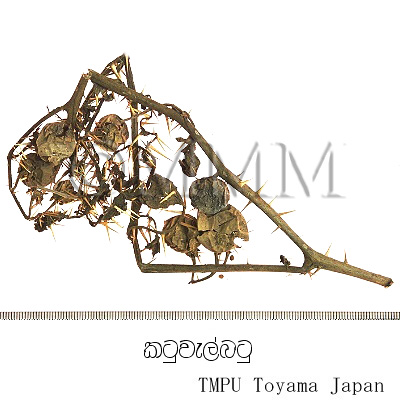Crude drug sample data base
※Click on the image to enlarge it.
Crude drug name | Market name | Katuwelbatu |
|---|---|---|
| Formal name | Kantakari | |
Other names Tips! | Kantakari (B), Ringni (H), Katuwelbatu (Sin) | |
| Original plant name | Solanum surattense Burm. f. (= Solanum xanthocarpum Schrad & Wendl.) | |
| Family name | Solanaceae | |
| Used part | Classification | Plant origin | Sub classification | whole plant |
| Collection information | Democratic Socialist Republic of Sri Lanka, Colombo | |
| Collection date | 1980/01/20 | |
| TMPW No. | 8667 | |
The capital city, provincial capital city or the representative
location of its administrative area is indicated.
location of its administrative area is indicated.
Production area information
https://ethmed.toyama-wakan.net/img/pin_san.png
6.9270786
79.86124300000006
Collection information
Democratic Socialist Republic of Sri Lanka,Colombo
https://ethmed.toyama-wakan.net/img/pin_nyu.png
Scientific information data base
| Crude drug name | Ayurvedic name or Sanskrit name, English name | Kantakari (Whole plant) | ||||
|---|---|---|---|---|---|---|
| crude drug image |
| |||||
| Original plant name | Solanum surattense Burm. f. (= Solanum xanthocarpum Schrad & Wendl.) | |||||
| Family name | Solanaceae | |||||
| Used part | Whole plant, Root, Fruit | |||||
| Distribution area | Occurs in India, tropical Asia, Australia and Polynesial Islands. It is a very common weed upto 6000 feet altitude in Ceylon. | |||||
| Common uses | The plant is antiinflammatory, anthelmintic, anodyne, digestive, carminative, stomachic, expectorant, laxative, diuretic, and aphrodisiac. It is useful in helminthiasis, dental caries, inflammation, flatulence, colic, constipation, dyspepsia, anorexia, leprosy, skin diseases, hypertension, rheumatoid arthritis, fever, cough, asthma, bronchitis, pharyngitis, hiccough, urolithiasis, strangury, amenorrhoea/amenorrhea, dysmenorrhoea/dysamenorrhea, lumbago, haemorrhoids/hemorrhoids, cardiac disorders, rhinopathy, epilepsy and catarrh. Kantakari is an important therapeutic agent for dislodging tenacious phlegm and is extensively used in the treatment of bronchial disorders. It is also useful in cases of enteric fever, bladder stones, difficult urination, enlargement of liver and spleen. Stem, flowers and fruits are bitter and carminative. They are prescribed for relief in burning sensation in the feet accompanied by vesicular watery eruptions. Leaves are used locally to relieve pain. Juice of the leaves mixed with black pepper is prescribed in rheumatism. Juice of berries is used in sore throat. Seeds are administered as an expectorant in asthma and cough. | |||||
| Chemical constituent | Others Alcoholic extracts of the plant contain fatty and resinous substances. Solasonine is present in fruits. The presence of diosgenin in the plant has been reported. The plant samples collected from Calcutta contained solasodine 0.0287% | |||||
| Pharmacological effect | Aqueous and alcoholic extracts of the plant possess hypotensive effect which is partly inhibited by atropine; the more persistent secondary fall in the blood pressure and bronchoconstriction are inhibited by the antihistamine drugs. Both glycoalkaloid and fatty acid fractions of the extract cause liberation of histamine from chopped lung tissue. Extracts of the whole plant show anti viral activity against Ranikhet disease virus and also against Sarcoma 180 in mice. Extraction of shoot and fruit show antibacterial activity against Staphylococcus aureus and Escherichia coli in phosphate buffer. The ethanolic extract of the stem exhibited antifungal activity against Aspergillus niger. The plant is reported to possess antiallergic activity. | |||||
| Medical system | Ayurveda (Traditional Indian medicine) | |||||
| References | Reference book Tips! | [2] Indian Medicinal Plants - A Compendium of 500 species, Varier, P.S., Orient Longman Ltd. Chennai (Madras) Vol. 5 (Repr.1997), p 164. Ayurvedic Drugs and Their Plant Sources, 1994. Sivarajan, V.V. and Balachandran, I., Oxford & IBH Publishing Co. Pvt. Ltd., New Delhi p 211. Medicinal plants (Indigenous and exotic) used in Ceylon, Vols. 1-5, 1982. Jayaweera, D.M.A., The National Science Council of Sri Lanka, Colombo Vol. 5, p 97. | ||||
| Last renewal date | 2023/12/21 | |||||




